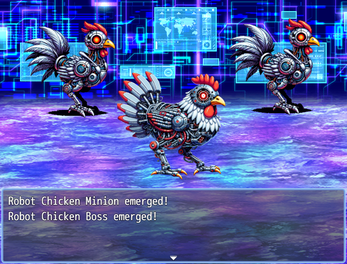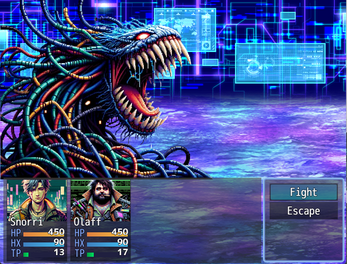TinyPunkRPG
0.1: Just testing RPGMaker MZ cyberpunk tilesets for my first project.
0.5: All maps are created and connected, items are given viable values, shops are created, random encounters are created in all dungeons, boss battle positions are added to maps (still need actual battles), and basic spells are added.
0.8: Fixed many connecting issues. All bosses are wired up, and lots of pathing is fixed.
I still need parallax/graphical overlay work to give some depth. No battle balancing is done yet.
0.9: BGM has been added to all scenes. Dungeons are better populated with detritus and triggers for all events should be operating properly. I spent an inordinate amount of time animating some things in one dungeon (Abandoned Gigafactory). Initial values have been given for mobs, bosses, skills, and items. Uploading this version to do a full run-through to find all the bugs and begin balancing.
1.0: General guidance is now provided throughout the entire game, leading you from quest to quest with increasing difficulty. I did some balancing on enemy stats and skills, and the ending should be able to be completed around level 20.
1.1: Rebalanced items, bosses, and some general defense values across the board. Changed items available in the shop to aid progression. Still a lot of bug fixes. Combat needs to be more interesting; need to research ideas for that.
Contains:
- 3 levels of "home" in the game to upgrade.
- 3 types of materials to craft and upgrade with.
- 2 available party members.
- 23 spell equivalents.
- 15 maps/scenes.
- 10 different mobs
- 4 "bosses" in 4 dungeons
Lessons learned from using RPGM for the first time and making any game for the first time:
- On RPGM itself: Nothing in RPGM looks like it is from 2020, and the logic for setting up triggers/events/everything that beeps and boops in the game is atrocious. This was very clearly built in 1998, and they are not afraid to keep it the same without improvement as long as they shovel out content to sell to people who will never release anything. This is all fine, but just be aware this is what RPGM is.
- I started without any plan, just fiddling with and downloading more assets. I quickly realized this would end like every other attempt without some kind of plan, so I went to my LucidChart account and created a very basic "one-page" design template to work with. Did I follow it 100%? Nope! But next time, I will put a lot more thought into this step.

- Organize your assets first. Create a folder infrastructure that aligns with the assets as they are imported into the Resource Manager in your local file system. When you download a new asset, decompress and sort immediately. If those assets require credit/attribution, create a text file with them in the same folder so you know when to include them.
- Even with planning against it - scope creep. I just wanted this to be my own tutorial for learning RPGM, and instead of taking a couple of days, it went into the full 30-day trial of RPGM. Even though this project does not reflect it, I understand how you can make some nice-looking JRPGs with the tool. The time required to make one small room/map/scene look spectacular (Square/Enix level) is extensive, and Photoshop is not optional.
- 95% of the time was spent poring over the maps and figuring out the archaic event system that controls everything. The event system is very clunky and uses standard dialog boxes, so you can't have multiple open and be working and referencing simultaneously.
- I am still terrible at tiling in the built-in editor, even for basic (flat) maps. I believe it is a disconnect in my ability to visualize using the individual tiles in the tileset to create a larger, more cohesive-looking map.
| Status | Released |
| Platforms | HTML5 |
| Author | Shearsonator13 |
| Genre | Role Playing |
| Made with | RPG Maker |
| Tags | Cyberpunk, RPG Maker, RPG Maker MZ |


Leave a comment
Log in with itch.io to leave a comment.